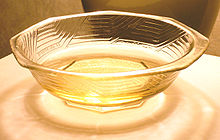- Mirin
-
Mirin (味醂 or みりん) is an essential condiment used in Japanese cuisine, consisting of 40%–50% sugar.[1] It is a kind of rice wine similar to sake, but with a lower alcohol content—14%[2] instead of 20%. There are three general types. The first is hon mirin (lit. true mirin),[3] which contains alcohol. The second is shio mirin, which contains alcohol as well as 1.5% salt[1] to avoid alcohol tax. The third is shin mirin (lit. new mirin),[4] or mirin-fu chomiryo (lit. mirin-like seasoning),[5] which contains less than 1% alcohol yet retains the same flavour.
In the Edo period, Mirin was drunk as a sweet sake.[6] Otoso, traditionally drunk on Shōgatsu, can be made by soaking a spice mixture in mirin.[7]
In the Kansai style of cooking, mirin is briefly boiled before using, to allow some of the alcohol to evaporate, while in the Kantō regional style, the mirin is used untreated. Kansai-style boiled mirin is called nikiri mirin (煮切り味醂),[8] literally "thoroughly boiled mirin."
Mirin is used to add a bright touch to grilled (broiled) fish or to erase the fishy smell. A small amount is often used instead of sugar and soy sauce. It should not be used in excess however, as its flavour is quite strong. It is sometimes used as a sushi accompaniment.
Mirin is used in teriyaki sauce.[5]
See also
- Japanese flavorings
References
- ^ a b "Diversified uses of Mirin". Taiwan News. Archived from the original on 2009-01-06. http://www.webcitation.org/5ddZvJOaz. Retrieved 2009-01-07.
- ^ Shimbo, Hiroko; Shimbo Beitchman (2000). The Japanese Kitchen: 250 Recipes in a Traditional Spirit. Ming Tsai. Harvard Common Press. p. 75. ISBN 9781558321779. http://books.google.ca/books?id=43puKgiAK2YC&pg=PA75. Retrieved 2009-01-06.
- ^ Yamaguchi, Roy; Joan Namkoong, Maren Caruso (2003). Hawaii Cooks: Flavors from Roy's Pacific Rim Kitchen. Ten Speed Press. p. 19. ISBN 9781580084543. http://books.google.ca/books?id=E1GFkVQac-YC&pg=PA19. Retrieved 2009-01-06.
- ^ Telford, Anthony (2003). The Kitchen Hand: A Miscellany of Kitchen Wisdom. Allen & Unwin. p. 153. http://books.google.ca/books?id=n0m46biu3ecC&pg=PA153. Retrieved 2009-01-06.
- ^ a b Shimbo, Hiroko; Shimbo Beitchman (2000). The Japanese Kitchen: 250 Recipes in a Traditional Spirit. Ming Tsai. Harvard Common Press. p. 77. ISBN 9781558321779. http://books.google.ca/books?id=43puKgiAK2YC&pg=PA77. Retrieved 2009-01-06.
- ^ Chiba, Machiko; 千葉真知子, J. K. Whelehan, Tae Hamamura, Elizabeth Floyd (2005). Japanese Dishes for Wine Lovers. Kodansha International. pp. 12. ISBN 9784770030030. http://books.google.ca/books?id=La1juytBR0EC&pg=PA12. Retrieved 2009-01-06.
- ^ Gauntner, John (2001-12-31). "An o-tososan a year keeps the doc away". The Japan Times. Archived from the original on 209-01-07. http://www.webcitation.org/5deGYnoDP. Retrieved 2009-01-07.
- ^ Tsuji, Shizuo; Mary Sutherland, Ruth Reichl, Yoshiki Tsuji (2007). Japanese Cooking: A Simple Art. Kodansha International. p. 219. ISBN 9784770030498. http://books.google.ca/books?id=fby2Er0seMMC&pg=PA219. Retrieved 2009-01-07.
Categories:- Japanese condiments
- Rice wine
Wikimedia Foundation. 2010.


